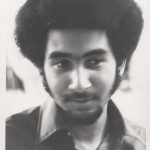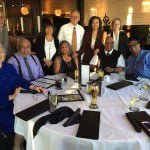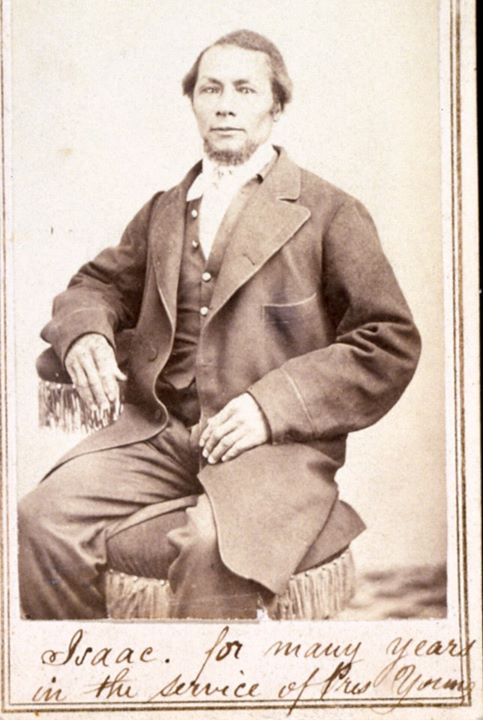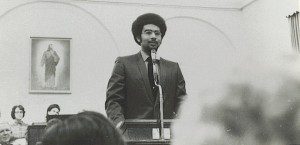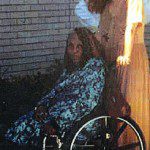Elsie Gray was close to miscarrying her baby, and had already had several miscarriages. She summoned the “Sisters”–Pentecostal women, who anointed her womb with consecrated oil and ministered to her, dedicating the fruit of her womb to God. Darius Aidan Gray was born healthy on December 12, 19?? (no, I won’t reveal his birth year), though he suffered health problems for much of his childhood.
As a teen, he read about Sampson and decided that he would do as Sampson did. He would not drink liquor. He would be strong in the Lord.
He was a searcher then, trying on one religion after another to see what fit. He loved his mother’s Pentecostal church, but it wasn’t quite right for him. His father attended a Methodist church every Father’s Day, but it wasn’t quite right for Darius either. It is either ironic or prophetic that Darius joined the Church of Jesus Christ of Latter-day Saints in 1964, after a revelatory experience which he tells without variation whenever he’s asked, “Why would a black man join a church which discriminated against him?” He says, “I received personal revelation, and was told ‘This is the restored gospel, and you are to join.’ No mention was made of the priesthood restriction.” I asked him once about that revelation. It was beyond a burning in the bosom, he said. It was indescribable, undeniable, and unmistakenly from God. He heard a divine voice declare, “This is the restored gospel.”
He quickly became “Brother Gray” when he took a job at KSL in Salt Lake City. He was a featured speaker at the “Know Your Religion” series, and seemed to be well respected, though he later learned that his colleagues at KSL had spoken ill of him, suggesting that he was only using the church for self-promotion. When Darius read those words in David O. McKay’s notes (at Gregory Prince’s library), he was deeply hurt.
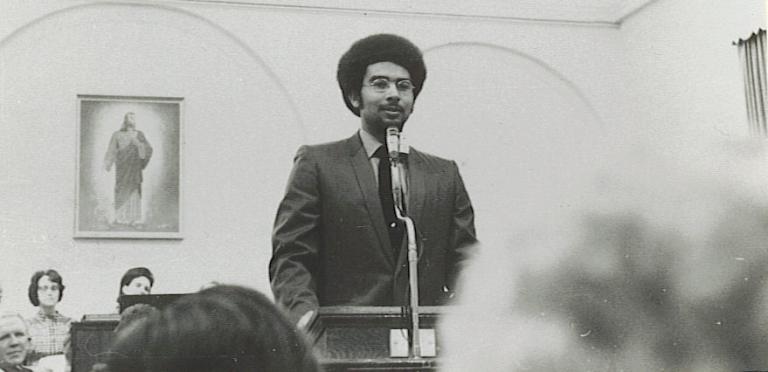
In October 1971, along with Ruffin Bridgeforth and Gene Orr, he answered the church’s invitation to preside over a support group for Latter-day Saints of African descent, called Genesis. He was devoted to the group for over a year, but as his marriage failed and he encountered deeper levels of racism than he had expected (this is discussed in special features of Nobody Knows: The Untold Story of Black Mormons), he became inactive and resumed smoking. He would often attend a portion of Sacrament meeting, sitting in the back and leaving early. He did not want to be “the Negro Mormon” at that time. He disliked being so conspicuous, especially when he was answering the same questions all the time. Why was he Mormon? Were Blacks cursed because of Cain or Canaan? Had he been “less valiant” in the pre-existence than those who received white bodies? We were recently given access to a tape Darius made in 1971 in which he says that apparently he didn’t want the priesthood in the pre-mortal life. Darius shook his head upon hearing his younger self say these words (echoing a deeply disturbing talk by Alvin Dyer). “I drank the Kool-Aid,” he said.
By the time I met him in 1998, he knew the full history of the priesthood restriction. In August of that same year, he had a rare spiritual experience in which he felt inspired that blacks were not cursed but CALLED to assignments they had agreed to before this life, that they knew they would be born into a time when prejudice was rife, and they would be tempted by bitterness. Likewise, others would be born into privilege and would be tempted by pride and exclusivity.
Darius was not active in the LDS church in 1978, though he continued to meet with Ruffin Bridgeforth, and performed the unpleasant task of scraping the gangrenous skin from Ruffin’s feet. He “snuck up on the church” in the early 1980s, and had a sacred experience in which he was instructed about the priesthood from a heavenly source. He was subsequently ordained to the priesthood and endowed, and said that after his endowment he was hesitant to even touch anyone for fear that the power of the temple would shock them.
I have never known Darius as a healthy man. He had been diagnosed with Chronic Fatigue Syndrome before I met him. Later, he learned that it was actually a kind of cancer called “polycythemia vera”, affecting the red blood cells. Besides this, he had heart problems (one by-pass operation) and back surgery.
And yet, he wouldn’t slow down. He attended baptisms, temple sealings, baby blessings, Genesis meetings, and did many firesides and lectures. I learned how to identify the look in his eye that told me I needed to get him to a room so he could rest. I did a solo trip to Jacksonville, Florida when Darius’s doctor said that he shouldn’t travel. Our contact there, Wiley Darden, accepted Darius’s bad news easily, and said he had had a dream that Darius had come to do the presentation and had been taken out by paramedics. He had had the dream three times. When I talked with Wiley, he told me, too, about the dreams. I asked, “In your dream, did Darius die?” Wiley paused and then said, “Yes. I didn’t tell him that part.” I replaced Darius that night, but used Bea Darden as my companion and soul friend. All understood that a red-headed white woman would be speaking rather than President Darius Gray–and they waded through their disappointment out of respect for Darius. But the event did tell us that we needed to be able to speak for one another. That a person of color should be able to tell “white” stories, and that a white person should know black history well enough (indeed is obligated to know it, particularly if they’re LDS) to stand in for a preferred black speaker.
In 2006, Darius wrote to President Hinckley about the racism he was still encountering, directed even towards black children. President Hinckley was disturbed by the news, and subsequently delivered a masterful sermon at General Conference, targeting racism. We cannot say how much Darius’s information affected President Hinckley, but we know that Darius was listened to, that his sense of things was valued by the Prophet.
Darius was not the author of the most recent church statement, but was certainly involved in helping to educate those who needed education. He is a trusted ally of LDS leaders, and works largely without receiving credit. He has lamented his years of inactivity and wondered what he might have contributed had he stayed fully involved. His current efforts are, in a way, repentance for what he didn’t do during his time away. And he has done all of his work, even until today, with poor health. He holds the world on his shoulders almost by habit, regardless of how he feels. As my mother says, “Most of the work in the world is done by people who ‘don’t feel very good.'” Darius has climbed spiritual mountains for those he loves at time when his body has resisted every step.
So, what does this new statement do which no other has done?
1) It clearly addresses the church’s history with the race issue, not simply alluding to “the past.”
2) It clearly addresses the fictional “curses” on Cain/Canaan–naming them–as justifications for the priesthood restriction. This is the one thing I have found missing in all statements about race made heretofore. This is the “naming of parts” of racism which I have yearned for.
3) It clearly repudiates past beliefs: “Today, the Church disavows the theories advanced in the past that black skin is a sign of divine disfavor or curse, or that it reflects actions in a premortal life; that mixed-race marriages are a sin; or that blacks or people of any other race or ethnicity are inferior in any way to anyone else. Church leaders today unequivocally condemn all racism, past and present, in any form.”
Would this statement have happened without Darius Gray? Yes. Darius could have chosen to remain inactive. Someone else would have replaced him. But even with serious health restrictions, Darius has chosen to answer God’s call whenever or wherever it comes. It is not mine to reveal how if in an way Darius affected the decision to construct and release this statement, but even if he had had no effect, he stands as a symbol of perseverance and commitment for all, black and white; male and female. He reclaimed his difficult assignments not just as the Genesis president but as a shepherd to any in need. He reclaimed these assignments even without physical strength, and has changed hearts and futures. He is beloved by Pastor Davis of Calvary Baptist Church, by Black scholars and humanitarians throughout the United States. The Utah NAACP gave him its Martin Luther King award, and he has been given a key to the city in Tennessee. Such honors pale, though, in light of his daily actions, his at-home “just as I am” persona. He re-builds cars. He jokes. He has invented a turbo super-charger for race cars. And he is a Zadik–a righteous man (as in MelchiZADIK). He doesn’t just honor his priesthood, he understands and treasures it. He renews his commitment daily to whatever God asks. He knows his history (his grandfather was born a slave) and shares it with love and pride, and he listens to those who are struggling under whatever burden they carry.
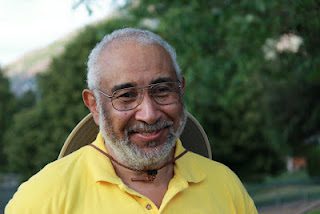
Those to whom he ministers rarely realize what weights he himself yet bears.


